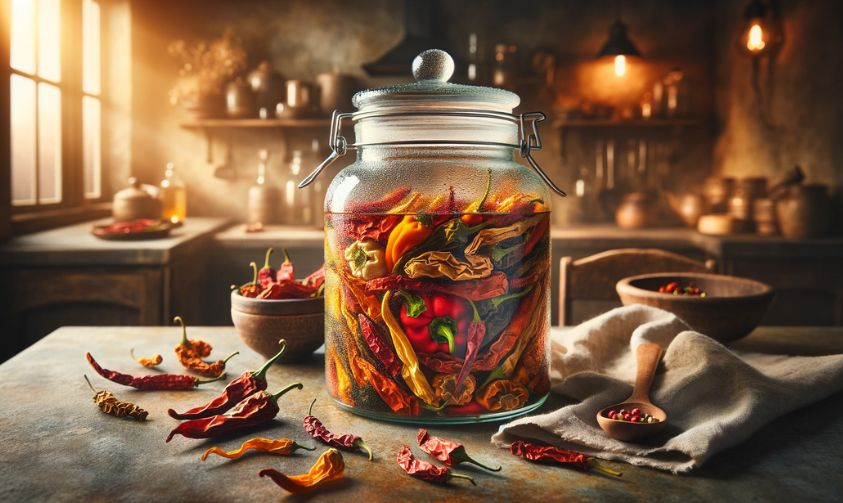Rehydrating dried peppers is a crucial step in culinary preparation, allowing them to release their full potential in your cooking. This article will guide you through the simple yet effective process on how to rehydrate dried peppers.
Let’s get into the heat of things.
To rehydrate dried peppers, you can soak them in warm water until they’re supple and plump. This method is suitable for all varieties of dried peppers, from the smoky chipotle to the fiery habanero.
If you are in a hurry, there’s also a quick method: cover the peppers with boiling water, and they will be ready to spice up your dishes in no time.

Steps to Rehydrate Dried Peppers
Selecting and Preparing the Peppers
Begin by choosing high-quality dried peppers. Look for ones that are flexible, indicative of a relatively recent harvest and a proper drying process.
Avoid any that show signs of mold or have a stale or off smell, as this can affect the taste and safety of your dish.
Once selected, prepare the peppers by removing the tops and shaking out the seeds if you prefer a milder heat.
For those who enjoy a spicier flavor, leaving some or all of the seeds in will enhance the piquancy.
Rinsing the Peppers
Rinsing is more than a cursory step—it’s about ensuring the purity and flavor of your rehydrated peppers.
Place them in a fine mesh strainer and wash them under a gentle stream of cool water.
This not only removes dust but also any lingering field residue.
Turn the peppers as you rinse, ensuring all sides are thoroughly cleansed. A meticulous rinse will result in a cleaner-tasting spice in your meals.
Soaking for Suppleness
Fill a heatproof bowl with hot water from the tap or kettle—just below a boil is ideal as excessively hot water can cook the peppers and alter their flavor.
Submerge the cleaned peppers in the water, ensuring they are fully covered.
The warmth will penetrate the dried flesh, reactivating the essential oils and compounds that give the peppers their characteristic heat and aroma.
This step is not to be rushed, as the gradual absorption of water is what will restore the peppers to a pliable state.
Ensuring Complete Hydration
As the peppers begin to absorb water, they may float to the surface.
To promote even hydration, submerge them with a small plate or lid that fits inside the bowl.
This gentle pressure will ensure all parts of the peppers are equally exposed to the water, allowing them to soften throughout consistently.
Time to Rehydrate
Patience is key in this step. For thin peppers, a soak of 20 to 30 minutes might suffice, but thicker varieties like Anchos or Mulatos may need up to an hour or even more.
Keep an eye on the texture; you are looking for a pepper that is flexible and has returned to a pliable, almost fresh state.
If after 30 minutes they still seem tough, give them more time, checking every 15 minutes to assess their progress.
Ready for Culinary Use
Once the peppers have reached the desired tenderness, carefully drain them and pat them dry with a paper towel or a clean cloth.
This is not merely about removing surface water; it’s about preparing the peppers to best absorb and integrate into your dish.
Whether you’re aiming to stuff them, chop them for a sauce, or puree them into a paste, rehydrated peppers should be devoid of excess moisture that could dilute flavors or alter cooking times.
Related Questions:
What is the best time to soak dried peppers?
The best time to soak dried peppers is typically when you have at least 30 minutes to spare, allowing them to fully rehydrate. Overnight soaking isn’t necessary unless you’re dealing with very thick peppers.
What are the benefits of soaking dried peppers?
Soaking dried peppers not only softens them for cooking but also helps to mellow their heat slightly, making them more versatile for various dishes. It also activates the oils within the peppers, intensifying their flavor and aroma.
Can I soak dried peppers in something other than water?
Absolutely! For an extra layer of flavor, you can soak dried peppers in broth, wine, or even a mixture of vinegar and water. This can impart unique tastes and make your dish even more special.
Can you freeze rehydrated dried peppers?
Yes, you can freeze rehydrated dried peppers. Drain them well, and lay them flat on a baking sheet to freeze individually before transferring them to a freezer bag. This prevents them from freezing into a solid block.
How can you quickly rehydrate dried peppers?
For a quick rehydration, cover the dried peppers with boiling water and let them steep for about 10 to 15 minutes. The hot water accelerates the process, making the peppers ready to use in a pinch.
Why won’t my dried peppers soften?
If your dried peppers won’t soften, they may require more time, especially if they are thicker or older. Another reason could be the quality of the peppers; some may have lost their ability to rehydrate properly if they are too old or were dried out excessively.
Can you soak dried peppers too long?
It is possible to over-soak dried peppers, especially thin ones, which can turn to mush if left in water for too long. Generally, 20 to 30 minutes should be sufficient. For thicker peppers, up to an hour may be necessary, but they should be checked periodically.
Can you soak dried peppers and then store them?
Once rehydrated, dried peppers should ideally be used immediately. However, if you need to store them, keep them in a container with a tight-fitting lid in the refrigerator. They can be stored for a couple of days when kept in a moist condition.


